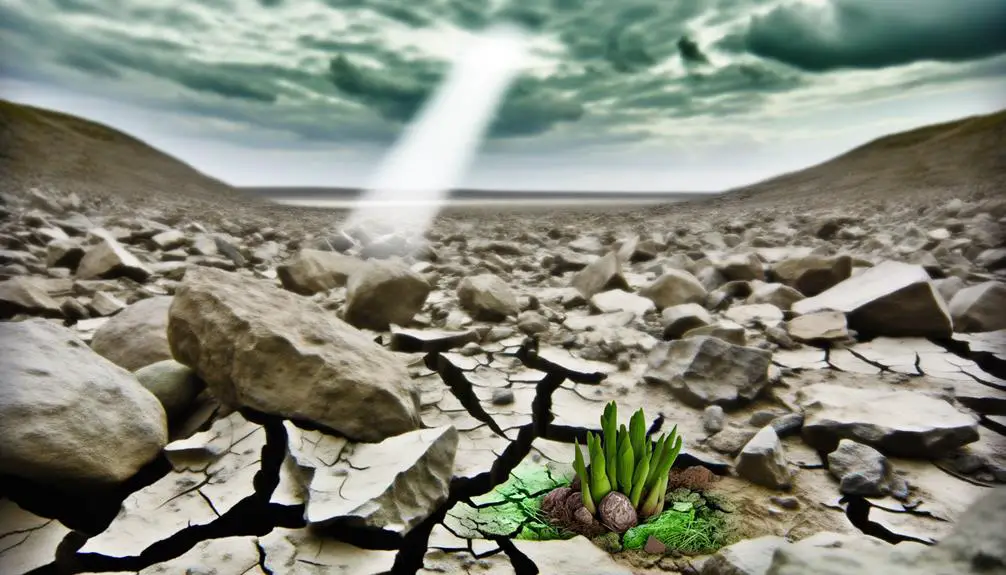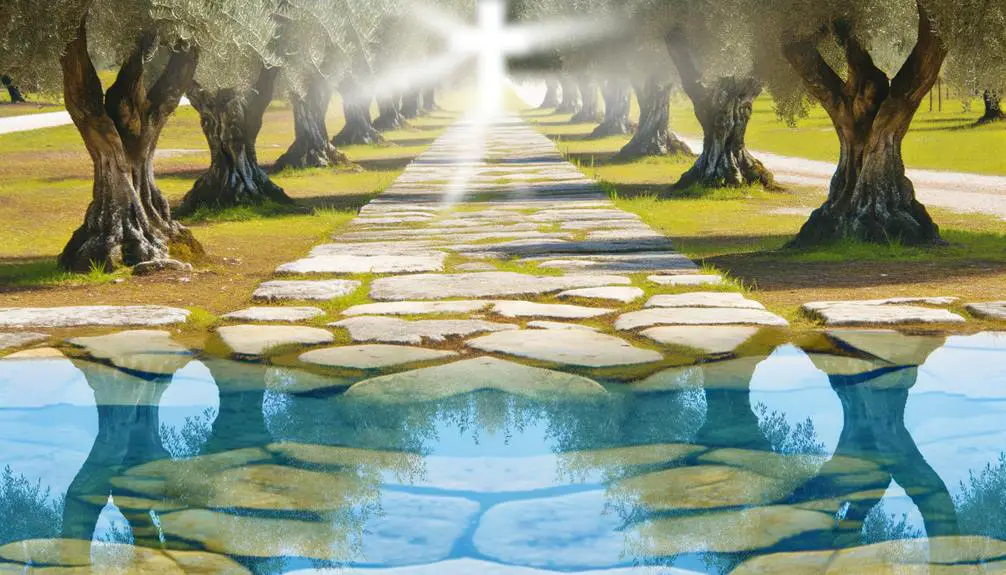Discover the profound lessons hidden in the Bible's stony ground, and how it shapes our spiritual journey today.

Stony Ground in the Bible
In the Bible, seeds sprout and wither, flourish and fail, all upon the stony ground that Jesus spoke of in the Parable of the Sower. You might wonder why this particular terrain holds such symbolic weight and what it can teach you about overcoming barriers to spiritual growth.
This parable, rich in historical context and brimming with spiritual implications, serves as a mirror reflecting the challenges and opportunities you face in your own journey. As you consider the stony ground's relevance in modern times, you'll find that the lessons it imparts are as pertinent today as they were millennia ago.
Uncover how this ancient wisdom can guide you in navigating the complexities of faith and life in a contemporary world.
Key Takeaways
- Stony ground in the Bible symbolizes obstacles to spiritual growth and the importance of a receptive heart.
- Overcoming the challenges of stony ground requires perseverance, faith nurturing, and adapting farming (or personal growth) techniques.
- The metaphor highlights the need for resilience in the face of societal, cultural, and environmental barriers.
- Personal and spiritual development involves deep reflection, overcoming limiting beliefs, and seeking supportive communities.
The Parable of the Sower

In the Parable of the Sower, Jesus' use of varied terrains, including stony ground, serves as a metaphorical framework for understanding the challenges of spiritual receptivity and growth. This narrative provides a rich tapestry for examining the intricacies of seed dispersal and planting techniques within a spiritual context. You'll find that the sower's approach to scattering seeds across different types of soil yields profound insights into the process of spiritual cultivation.
Seed dispersal, in this parable, isn't merely about the physical act of spreading seeds but rather symbolizes the dissemination of spiritual teachings across a diverse landscape of human hearts and minds. The varied responses to these teachings highlight the importance of the condition of the 'soil' upon which these 'seeds' fall. Stony ground, in particular, represents a challenging environment where initial growth is possible, but sustaining that growth becomes problematic due to a lack of depth.
The planting techniques implied in the parable suggest a non-discriminatory approach to sharing spiritual truths, akin to the sower who casts seeds everywhere, regardless of the immediate condition of the soil. This indiscriminate sowing reflects an optimistic faith in the potential for growth under varying circumstances, even in less-than-ideal conditions like stony ground.
Analyzing the sower's method offers a poignant lesson in persistence and hope in the face of adversity. It encourages a reflective consideration of one's own receptivity to growth and the nurturing of others' spiritual journeys, underscoring the resilience required to thrive despite the presence of obstacles.
Symbolism of Stony Ground

Delving into the symbolism of stony ground reveals its representation as a formidable barrier to spiritual growth and perseverance. In biblical narratives, this imagery often serves as a poignant reminder of the challenges faced in nurturing faith and moral integrity amidst adversity. Stony ground, with its harsh and unyielding nature, becomes a powerful metaphor for the obstacles that impede spiritual flourishing.
The symbolism extends into several dimensions:
- Rocky relationships: Just as seeds struggle to root in stony ground, individuals may find it difficult to cultivate deep, meaningful connections when faced with rocky relationships. These relationships, characterized by hardness and lack of emotional depth, mirror the barren landscape of stony ground, where growth is stifled and potential remains unfulfilled.
- Resistance to change: The unyielding nature of stony ground symbolizes the resistance encountered when attempting to foster change, either within oneself or within a community. This resistance can be a significant hindrance to spiritual and personal development, requiring persistent effort and resilience to overcome.
- Agricultural metaphors: The use of agricultural metaphors in depicting stony ground enriches the biblical narrative, providing a tangible representation of abstract spiritual concepts. Through these metaphors, the struggle against spiritual barrenness is vividly portrayed, highlighting the importance of perseverance and the nurturing of faith amidst challenges.
Historical Context

Understanding the symbolic significance of stony ground sets the stage for exploring its historical context within biblical narratives. When you delve into the agricultural practices of ancient times, you'll find that stony ground posed significant challenges. These rocky terrains were common in the regions described in the Bible, particularly in areas like Palestine, where agriculture was a cornerstone of life. The presence of stones in farming land wasn't just a minor inconvenience; it profoundly impacted the types of crops that could grow and the methods farmers used to cultivate their land.
This brings us to the geographical significance of stony ground in these narratives. The land's topography directly influenced the daily lives of its inhabitants. In regions where fertile soil was scarce, the presence of stony ground meant that agricultural practices had to be adapted. Techniques such as terracing were developed to make the most of the arable land available, showcasing the resilience and ingenuity of the people.
Moreover, the struggle with stony ground wasn't merely a physical battle; it was emblematic of the broader challenges faced by communities striving to flourish in harsh environments. The historical context of stony ground in the Bible reflects the perseverance required to transform unforgiving landscapes into productive fields. It serves as a testament to the determination of ancient peoples to overcome natural obstacles and sustain their communities through innovative agricultural practices.
Thus, the mention of stony ground in biblical texts isn't just a detail about the physical setting—it's a window into the historical realities of life in ancient times, highlighting the interplay between geography, agriculture, and human ingenuity.
Spiritual Implications

Beyond its historical and agricultural significance, stony ground frequently symbolizes spiritual challenges and opportunities for growth within biblical narratives. When you delve into these texts, you'll notice that the imagery of stony ground serves as a powerful metaphor for the state of the human heart and its receptiveness—or lack thereof—to spiritual teachings. This metaphor draws a direct line to the concept of heart hardening, an issue that's as relevant today as it was in ancient times.
The spiritual implications of stony ground can be broken down into three key areas:
- Heart hardening: This condition prevents the seed of wisdom or divine word from taking root. Just as seeds scatter on stony ground without penetrating the soil, spiritual teachings can bounce off a hardened heart, failing to inspire change or growth.
- Seed scattering: It's not just about the heart being hard; it's also about the dispersion of seeds. In a biblical context, this scattering represents the spread of divine messages across varied receptiveness, reminding you that not all teachings find fertile ground on the first try.
- Personal reflection and growth: Stony ground challenges individuals to examine their own hearts. Are there areas in your life where the soil has become compacted, unable to nurture the seeds of wisdom and transformation?
Overcoming Barriers to Growth

Recognizing the spiritual implications of stony ground lays the foundation for identifying and overcoming barriers to personal growth. This metaphorical terrain symbolizes both internal and external challenges that hinder spiritual and personal development. To navigate through these impediments, cultivating personal resilience becomes paramount. Personal resilience is the ability to bounce back from adversity, to learn from experiences and to continue growing despite the challenges. It's akin to the roots of a plant finding ways around rocks to reach the nutrients below.
External obstacles, on the other hand, are represented by the societal, cultural, or environmental factors that may limit one's growth. These can range from lack of access to educational resources, unsupportive social networks, to restrictive cultural norms. Overcoming these requires not just personal resilience but also an understanding of the systems in place and finding or creating supportive communities that encourage growth.
The process of overcoming these barriers involves a deep self-reflection on the nature of the obstacles, be they internal beliefs limiting one's potential, or external circumstances restricting one's opportunities. It's crucial to identify the specific nature of these barriers to address them effectively. Strategies might include seeking mentorship, engaging in continuous learning, and leveraging community resources.
In essence, overcoming the metaphorical stony ground involves a dual approach: strengthening personal resilience to navigate around internal barriers and strategically addressing external obstacles. This holistic approach ensures not just growth but a transformation that aligns with one's spiritual and personal goals.
Modern-Day Relevance

The metaphor of stony ground retains its relevance in today's society, reflecting the persistent challenges individuals face in achieving personal and spiritual growth. This concept, deeply embedded in biblical teachings, transcends its ancient origins, illuminating contemporary issues through a lens that's both reflective and instructive. The allegory serves as a powerful tool in understanding the complexities of modern life, particularly when examining themes such as ecological conservation and the myriad societal metaphors that echo the struggles against a backdrop of adversity.
Here are three ways the metaphor of stony ground resonates with current themes:
- Ecological Conservation: The stony ground metaphor highlights the importance of preparing the earth for sustainable growth, mirroring the global emphasis on ecological conservation. Just as seeds struggle to root in stony soil, our efforts for environmental preservation face obstacles in the form of pollution, deforestation, and climate change. The metaphor encourages a reevaluation of our practices and a commitment to nurturing a healthier planet.
- Societal Metaphors: In societal contexts, stony ground symbolizes the challenging environments that hinder personal and collective progress. From systemic inequalities to cultural barriers, these 'stony' conditions impede the growth of communities and individuals alike. The metaphor urges a rethinking of societal structures to foster inclusivity and opportunity.
- Personal Growth: On a personal level, stony ground represents the internal and external barriers to spiritual and personal development. It prompts a reflection on the resilience needed to overcome obstacles and the importance of creating fertile ground for growth within oneself.
Through these lenses, the metaphor of stony ground serves as a poignant reminder of the enduring struggles and aspirations that define the human condition, urging a thoughtful engagement with the world around us.
Reflective Practices for Believers

Engaging in reflective practices allows believers to navigate the complexities of their faith journey, fostering deeper understanding and spiritual growth. Among these practices, mindful meditation and prayer journaling stand out as powerful tools for cultivating a rich, introspective relationship with one's beliefs and values.
Mindful meditation, a practice deeply rooted in attentiveness and awareness, encourages you to focus on the present moment, acknowledging your thoughts and feelings without judgment. This method of reflection is instrumental in developing a heightened sense of spiritual consciousness. It enables you to discern the divine presence in everyday life, fostering a deeper connection with your faith. Through mindful meditation, you're not just passing through your spiritual journey; you're actively engaging with it, uncovering layers of meaning that previously eluded you.
Prayer journaling, on the other hand, offers a tangible approach to reflective practice. By documenting your prayers, thoughts, and the responses you perceive from the divine, you create a physical record of your spiritual evolution. This practice not only aids in processing complex emotions and thoughts but also serves as a testament to the milestones and challenges encountered along your faith journey. Prayer journaling encourages a disciplined approach to reflection, requiring you to articulate your innermost feelings and aspirations. This deliberate act of expression deepens your understanding of personal faith and fosters a more intimate dialogue with the divine.
Incorporating mindful meditation and prayer journaling into your routine can significantly enhance your spiritual journey. These reflective practices empower you to confront and comprehend the multifaceted nature of your faith, leading to profound personal growth and enriched spiritual understanding.
Frequently Asked Questions
How Do Agricultural Practices in Ancient Times Compare to Modern Methods in Terms of Dealing With Stony Ground?
When comparing ancient agricultural practices to modern methods for dealing with stony ground, you'll find significant differences.
In ancient times, stone removal and crop selection were manual and labor-intensive, relying on simple tools and indigenous knowledge.
Today, advanced machinery and scientific research streamline stone removal, while crop selection is optimized through genetic engineering and soil analysis.
This evolution reflects a shift from manual labor to technology-driven solutions, greatly enhancing efficiency and productivity.
Are There Specific Locations Mentioned in the Bible That Were Known for Their Stony Terrain, and How Have These Places Changed Over Time?
You're delving into locations historically heralded for their stony terrain, keen to uncover how these places have pivoted over periods.
Stony parables pepper texts with their geographical significance, shaping narratives and beliefs. Analyzing these areas, you'll notice a transformation from mere physical landscapes to symbols of cultural and historical importance.
As time trod on, these stony sites evolved, reflecting changes in societal values, agricultural practices, and environmental conditions.
How Has the Interpretation of the Symbolism of Stony Ground Evolved Within Different Christian Denominations Throughout History?
You're exploring how theological interpretations of stony ground have shifted among Christian denominations over time.
This journey reveals significant denominational differences, reflecting evolving doctrines and cultural contexts.
Initially, interpretations were fairly uniform, but as denominations emerged, they began to ascribe unique meanings to this symbolism, influenced by theological priorities and historical experiences.
This diversity showcases the rich tapestry of Christian thought and how it adapts to changing times and understandings.
What Are the Ecological Impacts of Stony Ground, and How Did Ancient Communities Adapt Their Land-Use Strategies to Cope With These Challenges?
You're navigating the rocky terrain of understanding stony ground's ecological impacts and ancient land-use strategies. Stony ground challenges include reduced soil fertility, as rock decomposition is slow, limiting nutrient availability.
Yet, ancient communities were no strangers to adaptation. They improved soil fertility through innovative practices like terracing and adding organic matter, turning these challenges into opportunities for sustainable agriculture, showcasing their resilience and ingenuity in the face of environmental adversities.
Can the Concept of Stony Ground Be Found in Religious Texts Outside of Christianity, and if So, How Is It Portrayed Differently?
You're exploring whether religious texts beyond Christianity reference stony ground, focusing on its portrayal. In your analysis, consider geological symbolism and cultural metaphors, recognizing that these texts may use stony ground to symbolize spiritual or moral challenges.
Different traditions could offer varied interpretations, reflecting their unique cultural and environmental contexts. This exploration helps you understand the broader significance of stony ground in religious narratives, highlighting its role beyond a mere physical obstacle.
Conclusion
In exploring the stony ground within the biblical narrative, you've traversed from the parable's ancient roots to its profound modern-day relevance. By analyzing its symbolism, historical context, and the spiritual lessons it imparts, you've uncovered the enduring struggle and potential for personal growth amidst adversity.
Reflective practices offer a path forward, bridging past wisdom with present challenges. Thus, the journey from stony ground to fertile soil becomes not just a biblical tale, but a mirror to your own spiritual growth.



Sign up